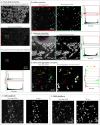A platform-independent framework for phenotyping of multiplex tissue imaging data
- PMID: 37733781
- PMCID: PMC10547204
- DOI: 10.1371/journal.pcbi.1011432
A platform-independent framework for phenotyping of multiplex tissue imaging data
Abstract
Multiplex imaging is a powerful tool to analyze the structural and functional states of cells in their morphological and pathological contexts. However, hypothesis testing with multiplex imaging data is a challenging task due to the extent and complexity of the information obtained. Various computational pipelines have been developed and validated to extract knowledge from specific imaging platforms. A common problem with customized pipelines is their reduced applicability across different imaging platforms: Every multiplex imaging technique exhibits platform-specific characteristics in terms of signal-to-noise ratio and acquisition artifacts that need to be accounted for to yield reliable and reproducible results. We propose a pixel classifier-based image preprocessing step that aims to minimize platform-dependency for all multiplex image analysis pipelines. Signal detection and noise reduction as well as artifact removal can be posed as a pixel classification problem in which all pixels in multiplex images can be assigned to two general classes of either I) signal of interest or II) artifacts and noise. The resulting feature representation maps contain pixel-scale representations of the input data, but exhibit significantly increased signal-to-noise ratios with normalized pixel values as output data. We demonstrate the validity of our proposed image preprocessing approach by comparing the results of two well-accepted and widely-used image analysis pipelines.
Copyright: © 2023 Ahmadian et al. This is an open access article distributed under the terms of the Creative Commons Attribution License, which permits unrestricted use, distribution, and reproduction in any medium, provided the original author and source are credited.
Conflict of interest statement
The authors have declared that no competing interests exist.
Figures




References
Publication types
MeSH terms
Grants and funding
LinkOut - more resources
Full Text Sources

